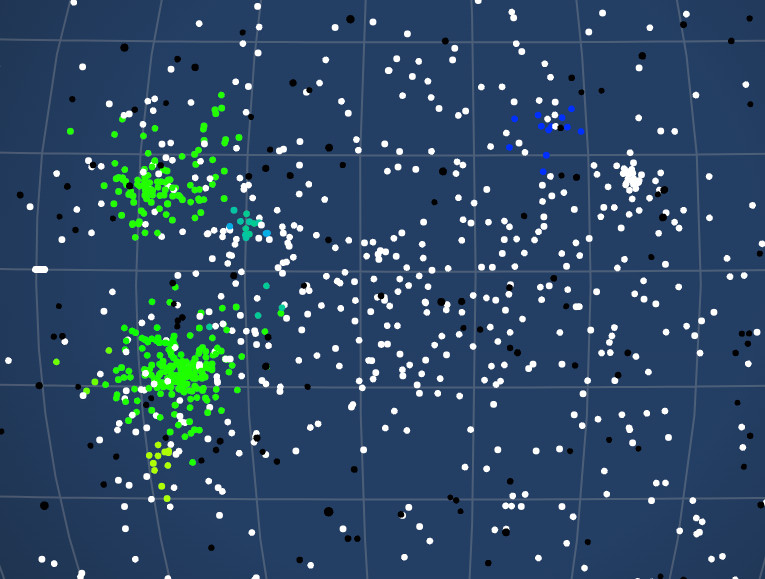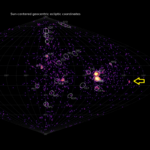Abstract: A meteor outburst was detected during the Perseid shower season in 2024, radiating from near the star nu Cap. The shower was active from August 3 to 16, and was not seen in prior years. The origin is uncertain. The radiant is just below that of the alpha-Capricornids from 169P/NEAT at this time of year and further west from the radiant position of the August delta-Capricornids from 45P/Honda-Mrkos-Pajdusakova.
Introduction
Observers during this year’s Perseid meteor shower, especially the ones with dark and clear skies, may have noticed something unusual: slow meteors from the south adding to the usual Perseid display of fast meteors from the north-east. Between August 10 and 15, slow meteors radiated from near the star nu Cap (Jenniskens, 2024). The meteors were visible to the naked eye, but mostly faint. This nu-Capricornids meteor shower is new to astronomers and was detected by low-light video cameras all over the globe (http://cams.seti.org/FDL/ for dates of August 10-15, 2024). The new shower is caused by a yet-to-be-identified comet or primitive asteroid that lost material in the recent past.
Observations
The shower was first noticed on August 10 (http://cams.seti.org/FDL/ for date of 2024-08-10) as a dense cluster of radiants in the anthelion source. The shower continued to stand out above the background until August 16. After extracting the orbits, the shower appears to have been first detected above the sporadic background on August 3, but rates stayed low in that first week. The shower spanned the solar longitude range of 131.3 to 143.5 degrees, centered on 139.05 degrees (equinox J2000), one day earlier than the peak of the Perseid shower.
In total, 130 orbits were measured by CAMS and Global Meteor Network stations. Sixty-two new shower meteors were triangulated by CAMS New Zealand (coordinated by J. Baggaley, University of Canterbury; and J. Scott, University of Otago), 24 by CAMS Australia (H. Devillepoix, Curtin University; D. Rollinson), 19 by CAMS BeNeLux (C. Johannink, M. Breukers), 11 by LO-CAMS in Arizona (N. Moskovitz, Lowell Observatory), 6 by CAMS Namibia (T. Hanke, E. Fahl, R. van Wyk, HESS Collaboration), 3 by CAMS Chile (S. Heathcote and T. Abbott, NOIRLAB and Cerro Tololo; E. Jehin, University of Liege), 3 by the UAE astronomical Camera Network (M. Odeh, International Astronomical Center), one by CAMS Arkansas (L. Juneau), and one by CAMS California (J. Albers, B. Grigsby, E. Egland, and T. Beck).
Figure 1 – Radiant map on August 15, 2024, with arrow marking the new shower.
Table 1 summarizes the median radiant, speed and orbital elements. The radiant drift was +0.40 deg/day in R.A. and +0.26 deg/day in Decl., while the orbital elements changed along the Earth’s path at a rate of +0.006 AU/day in q, +0.03 deg/day in i, and -0.89 deg/day in the longitude of perihelion Pi.
The results are compared to those for the annual epsilon-Aquariids from comet 169P/NEAT (Jenniskens, 2023), which are close to the position of the alpha-Capricornids in mid August, and the 2022 outburst of August delta-Capricornids from comet 45P/Honda-Mrkos-Pajduskaova (Jenniskens, 2022; Roggemans et al., 2022).
Table 1 – The median orbital elements (Equinox J2000.0) compared to nearby showers.
| nu-Capricornids
2024 |
epsilon-Aquariids
(annual) |
August delta-Capricornids
2022 |
|
| λʘ (°) | 139.05 | 136.7 | 143.1 |
| αg (°) | 306.65 +/- 0.14 | 310.8 | 324.7 +/- 0.2 |
| δg (°) | -11.38 +/- 0.09 | -6.4 | -11.6 +/- 0.3 |
| vg (km/s) | 18.34 +/- 0.08 | 20.1 | 24.2 +/- 0.3 |
| λ – λʘ (°) | 166.74 +/- 0.18 | 174.3 | 180.0 |
| β (°) | +7.62 +/- 0.07 | +11.2 | +2.3 |
| a (AU) | 2.94 +/- 0.03 | 2.42 | 3.16 |
| q (AU) | 0.749 +/- 0.02 | 0.665 | 0.547 +/- 0.025 |
| e | 0.745 +/- 0.003 | 0.728 | 0.823 +/- 0.069 |
| ω (°) | 247.0 +/- 0.3 | 259.0 | 270.9 +/- 1.7 |
| Ω (°) | 139.1 +/- 0.3 | 136.7 | 143.2 +/- 0.4 |
| i (°) | 4.17 +/- 0.04 | 7.16 | 1.9 +/- 1.3 |
| Π (°) | 26.4 +/- 1.2 | 36.4 | 54.5 +/- 1.0 |
| Tj | 2.75 +/- 0.19 | 3.08 | 2.58 +/- 0.50 |
| N | 130 | 438 | 36 |
Discussion
At this point in time, it is unclear what may be the source of this shower. Another outburst with a radiant in Capricorn was observed in 2022, when meteoroids from comet 45P/Honda-Mrkos-Pajdusakova were intercepted by Earth (Sekiguchi, 2022). The radiant of the new shower this year was nearly 20 degrees further west and the geocentric velocity was lower by 6 km/s. The longitude of perihelion of the resulting orbit is lower by almost 30 degrees.
It is perhaps more likely that the shower is related to the alpha-Capricornids. However, the shower radiant was significantly below and to the west of that of the alpha-Capricornids at this time of year. This shower has a component slightly offset called the epsilon-Aquariids (Table 1). The longitude of perihelion of the new shower is 10 degrees below that of these showers associated with 169P/NEAT.
Acknowledgements: I thank the CAMS station and network operators for a successful 2024 Perseid shower campaign. Especially CAMS BeNeLux had outstanding results. I thank Dave Samuels and Steve Rau for maintaining the CAMS operations. Many Global Meteor Network stations were established in and around CAMS networks and these contributed a majority of the results described here. I thank D. Vida, P. Roggemans, N. Moskovitz, D. Rollinson and J. Scott for making this possible.
References
Jenniskens P. (2022a). “Ongoing outburst from a new radiant on Aquarius/Capricorn border”. eMetN Meteor Journal, 7, 304–305.
Jenniskens P. (2022b). “August delta Capricornids meteor shower 2022”. eMetN Meteor Journal, 7, 306.
Jenniskens P. (2023). Atlas of Earth’s Meteor Showers, Amsterdam: Elsevier, 838 pp. (page 579).
Jenniskens P. (2024) CBET 5434. Ed.: D. W. E. Green. Cambridge: Central Bureau for Astronomical Telegrams.
Roggemans P., Segon D., Vida D., Greaves J., Sekiguchi T., Angelsky A., Davydov A. (2022). “Near anti-helion meteor shower outburst recorded by Global Meteor Network”. eMetN Meteor Journal, 7, 293–301.
Sekiguchi T. (2022). “New radiant on Aquarius/Capricorn border by the SonotaCo Network”. eMetN Meteor Journal, 7, 302–304.





